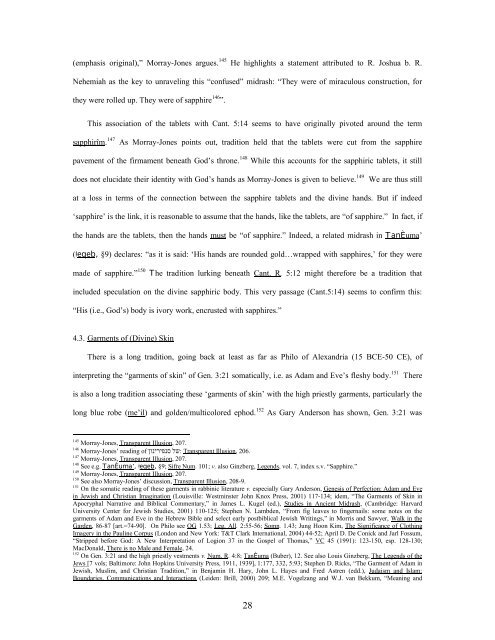Sapphiric God: - Dr. Wesley Muhammad
Sapphiric God: - Dr. Wesley Muhammad
Sapphiric God: - Dr. Wesley Muhammad
You also want an ePaper? Increase the reach of your titles
YUMPU automatically turns print PDFs into web optimized ePapers that Google loves.
(emphasis original),” Morray-Jones argues. 145 He highlights a statement attributed to R. Joshua b. R.<br />
Nehemiah as the key to unraveling this “confused” midrash: “They were of miraculous construction, for<br />
they were rolled up. They were of sapphire 146 ”.<br />
This association of the tablets with Cant. 5:14 seems to have originally pivoted around the term<br />
sapphirîm. 147 As Morray-Jones points out, tradition held that the tablets were cut from the sapphire<br />
pavement of the firmament beneath <strong>God</strong>’s throne. 148 While this accounts for the sapphiric tablets, it still<br />
does not elucidate their identity with <strong>God</strong>’s hands as Morray-Jones is given to believe. 149 We are thus still<br />
at a loss in terms of the connection between the sapphire tablets and the divine hands. But if indeed<br />
‘sapphire’ is the link, it is reasonable to assume that the hands, like the tablets, are “of sapphire.” In fact, if<br />
the hands are the tablets, then the hands must be “of sapphire.” Indeed, a related midrash in TanÈuma’<br />
(#eqeb, §9) declares: “as it is said: ‘His hands are rounded gold…wrapped with sapphires,’ for they were<br />
made of sapphire.” 150 The tradition lurking beneath Cant. R. 5:12 might therefore be a tradition that<br />
included speculation on the divine sapphiric body. This very passage (Cant.5:14) seems to confirm this:<br />
“His (i.e., <strong>God</strong>’s) body is ivory work, encrusted with sapphires.”<br />
4.3. Garments of (Divine) Skin<br />
There is a long tradition, going back at least as far as Philo of Alexandria (15 BCE-50 CE), of<br />
interpreting the “garments of skin” of Gen. 3:21 somatically, i.e. as Adam and Eve’s fleshy body. 151 There<br />
is also a long tradition associating these ‘garments of skin’ with the high priestly garments, particularly the<br />
long blue robe (me’il) and golden/multicolored ephod. 152 As Gary Anderson has shown, Gen. 3:21 was<br />
145<br />
Morray-Jones, Transparent Illusion, 207.<br />
146<br />
Morray-Jones’ reading of ןוניריפנס לש: Transparent Illusion, 206.<br />
147<br />
Morray-Jones, Transparent Illusion, 207.<br />
148<br />
See e.g. TanÈuma’, #eqeb, §9; Sifre Num. 101; v. also Ginzberg, Legends, vol. 7, index s.v. “Sapphire.”<br />
149<br />
Morray-Jones, Transparent Illusion, 207.<br />
150<br />
See also Morray-Jones’ discussion, Transparent Illusion, 208-9.<br />
151<br />
On the somatic reading of these garments in rabbinic literature v. especially Gary Anderson, Genesis of Perfection: Adam and Eve<br />
in Jewish and Christian Imagination (Louisville: Westminster John Knox Press, 2001) 117-134; idem, “The Garments of Skin in<br />
Apocryphal Narrative and Biblical Commentary,” in James L. Kugel (ed.), Studies in Ancient Midrash, (Cambridge: Harvard<br />
University Center for Jewish Studies, 2001) 110-125; Stephen N. Lambden, “From fig leaves to fingernails: some notes on the<br />
garments of Adam and Eve in the Hebrew Bible and select early postbiblical Jewish Writings,” in Morris and Sawyer, Walk in the<br />
Garden, 86-87 [art.=74-90]. On Philo see QG 1.53; Leg. All. 2:55-56; Somn. 1.43; Jung Hoon Kim, The Significance of Clothing<br />
Imagery in the Pauline Corpus (London and New York: T&T Clark International, 2004) 44-52; April D. De Conick and Jarl Fossum,<br />
“Stripped before <strong>God</strong>: A New Interpretation of Logion 37 in the Gospel of Thomas,” VC 45 (1991): 123-150, esp. 128-130;<br />
MacDonald, There is no Male and Female, 24.<br />
152<br />
On Gen. 3:21 and the high priestly vestments v. Num. R. 4:8; TanÈuma (Buber), 12. See also Louis Ginzberg, The Legends of the<br />
Jews [7 vols; Baltimore: John Hopkins University Press, 1911, 1939], 1:177, 332, 5:93; Stephen D. Ricks, “The Garment of Adam in<br />
Jewish, Muslim, and Christian Tradition,” in Benjamin H. Hary, John L. Hayes and Fred Astren (edd.), Judaism and Islam:<br />
Boundaries, Communications and Interactions (Leiden: Brill, 2000) 209; M.E. Vogelzang and W.J. van Bekkum, “Meaning and<br />
28
















